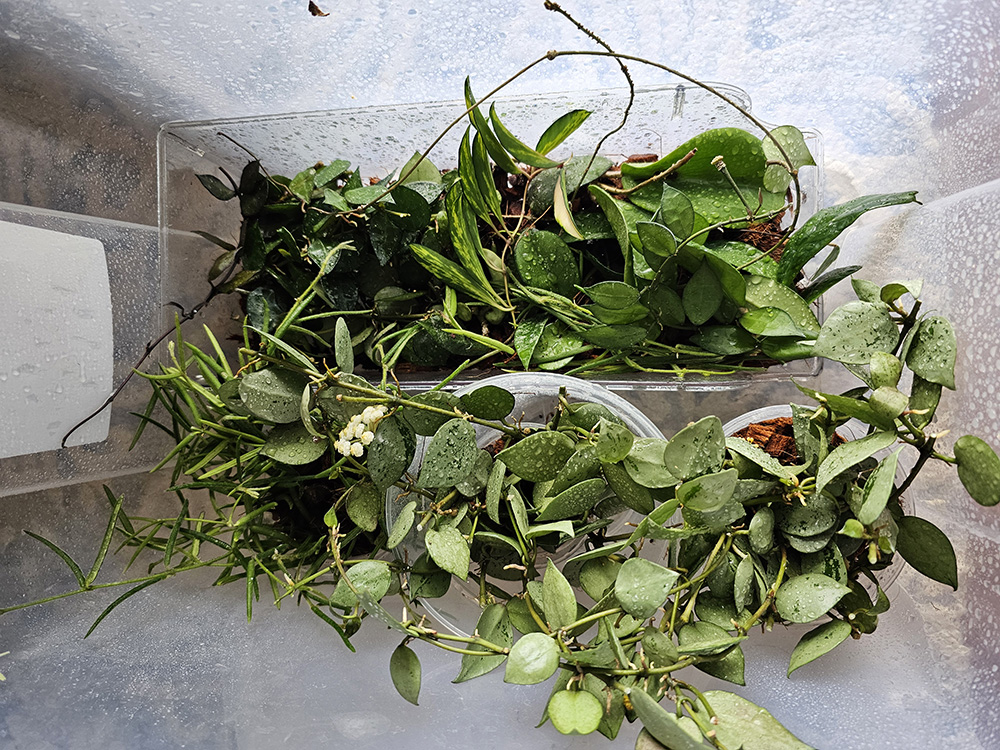Garden update
Summer is gone! Outside of summer my porch starts to get direct light for several hours a day. This is when most plants start to really grow and show their sun stress. Many of the hoyas that are sensitive to drops in temperature go indoors on windowsills. The remaining hoyas have been hardy throughout the years, handling drops in temperature down to ~40 °F (4 °C).
Hoya Sunrise
Hoya Sunrise is a striking hoya hybrid – a mix between lacunosa and obscura. Sunrise leaves start out green and progressively get redder with more sunlight. In my experience, it can gradually take direct light when gradually exposed to more and more light. Cooler temperatures can also bring out the coloring. Here is one of my favorite examples of a sunrise.
It is hard to overwater a sunrise in a coco mixture. I have several plants that sit in cache pots with their bottom barely touching the water below. The roots grow quickly and vigorously in these conditions. Sunrise does not seem very sensitive to underwatering either. Forgetting to water and allowing the pot to dry out completely can be remedied by simply watering thoroughly.
Cuttings can be taken and grow strong roots surprisingly fast. Some cuttings start growing out their air roots within a day or two with humid conditions and warm temperatures.
Sunrise blooms very quickly with little effort. Adding orchid fertilizer or a general 20-20-20 fertilizer, diluted at half strength, can force peduncles rather quickly compared to other hoyas. Once established, this hoya flowers frequently and blooms have a jasmine-citrus scent (in my opinion).
Hoya lacunosa
This hoya can be tricky for many as its thin leaves don’t allow excess water storage. Lacunosa can easily develop root rot from over or underwatering. Plant in a coarse mix that includes perlite or granite chips, or an airy substrate that dries out quickly. Some grow in semi-hydroponic setups, but my best growing lacunosa is in a coco lined hanging basket with 70% coco chunks and some succulent mix to keep it from drying out in the basket. Coco lined baskets tend to dry out very fast so keep that in mind.
Other lacunosa cuttings are planted in clear pots with coco chunks. These are allowed to nearly dry out (70%) and then watered deeply.
Light requirements are bright indirect light. Direct light scorches the leaves and scars permanently – scorched areas appear light yellow/tan and look sunken in. More light causes the leaves to shrink in length. Leaves become more compact. Less light causes leaves to elongate and grow longer.
Lacunosa flowers frequently throughout the year if fertilized regularly. Once established, this hoya can develop dozens of blooms that flower repeatedly and fill the air with a floral jasmine scent. When fertilizing, as with all hoyas, use half strength fertilizer every few waterings. You can also use foliar orchid spray.
Hoya kerrii inner variegated
Hoya kerrii sports thick heart-shaped leaves. Kerrii requires well draining soil and dappled to bright light. Kerriis are often sold as single leaf decorative plants – though many of these are planted without a node and will never sprout more leaves. If you want a kerrii that grows into a large, multi-leaved plant, opt for one with two or more leaves and nodes like below.
This hoya is new to my care. So far it has grown quite slowly. Kerrii was placed in a semi-shaded area that receives 3 or more hours or morning sunlight. It is currently in the same location near my hoya obovata who also likes dappled sun. If your hoya seems stagnant, try moving it to a different area and watch it closely for burns, growth, or sensitivities.
Kerrii likes to be ignored and has only been watered after the coco husk has dried out 90%. When coco turns lighter colors, that means it’s drying out.
It has been putting new growth out during winter conditions – some days as warm as 70 °F (21 °C), some days as cold as 40 °F (4 °C).
Hoya surigaoensis
Hoya surigaoensis is another hoya that shows beautiful sun stress. Like many of my larger hoyas on the balcony, this one lives in a cache pot. It also has a coco husk substrate. It was grown from a two-leaf cutting, you can see it here. It’s the biggest set of leaves in the first picture.
I love this hoya because it is so simple to keep happy. Give it as much sun as possible to watch it develop maroon foliage. It will grow just fine in part shade as well, it just stays more lime colored.
This hoya sits in a cache pot with an inch of water at the bottom. Roots can reach down to drink whenever needed. I water from above and allow the excess to fall into the cache. It needs watering every few weeks and sometimes even less than that. That’s it!


